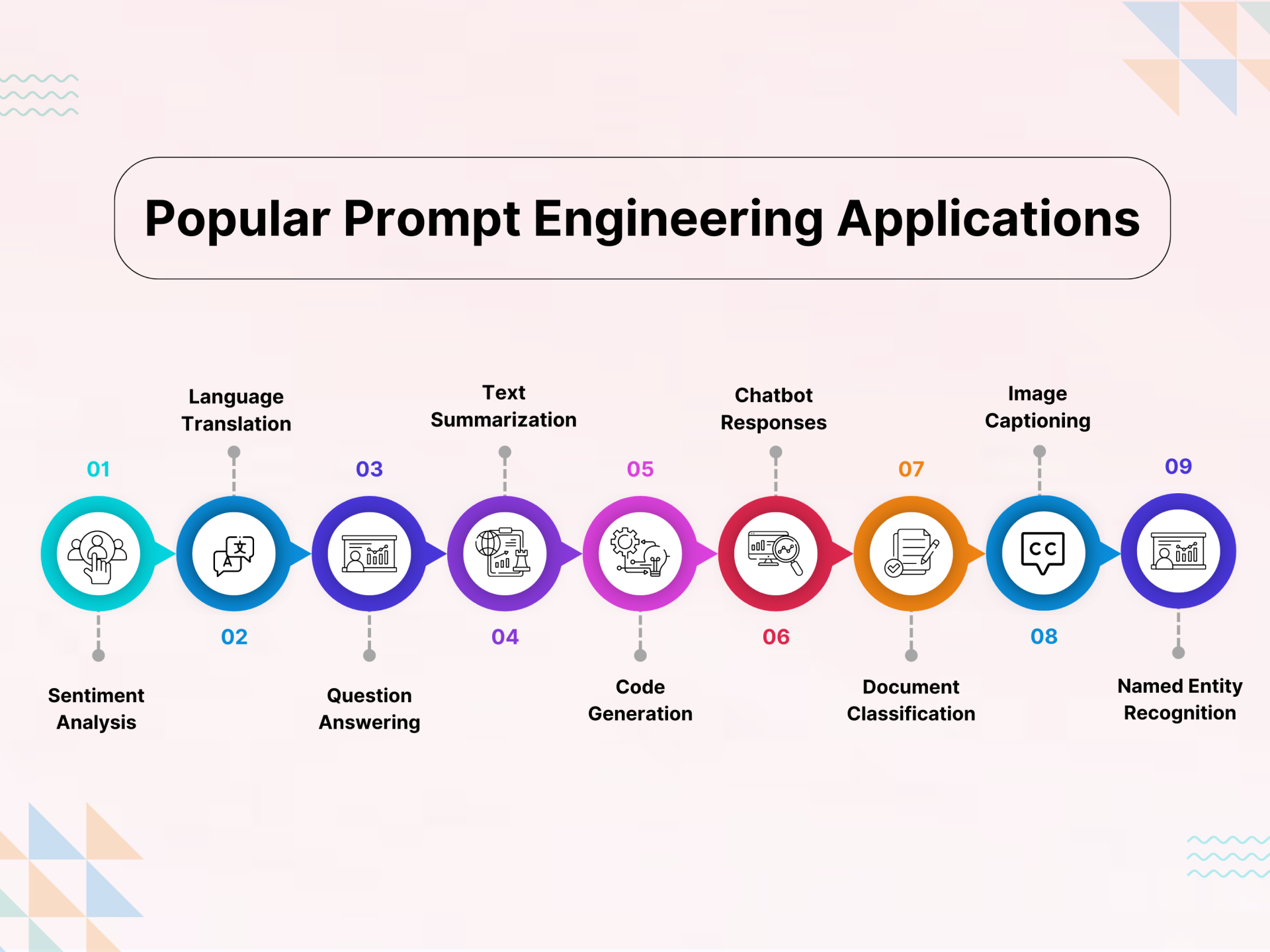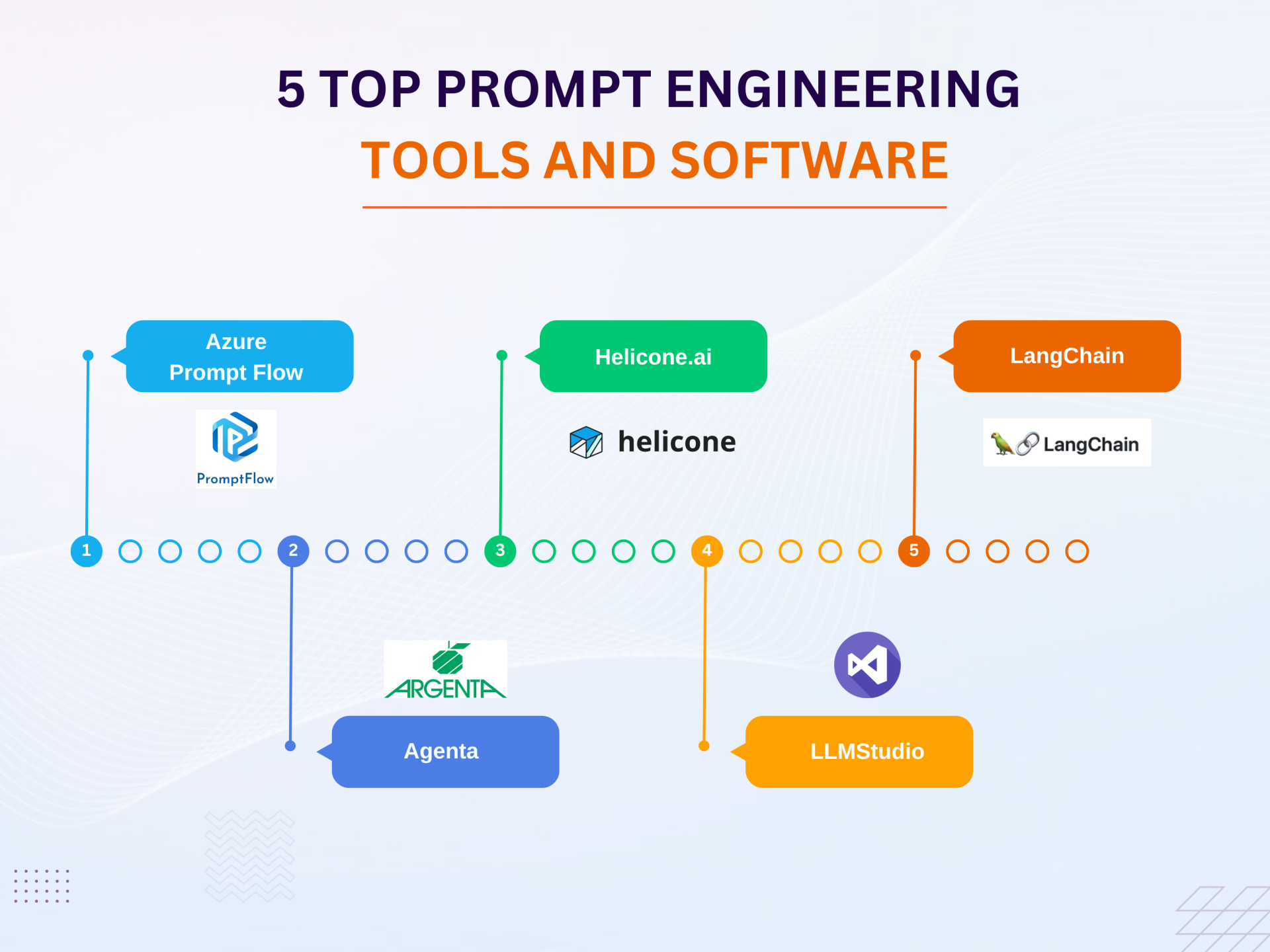As we delve deeper into today’s digital age, we are seeing technology take new leaps & bounds. The most recent advancement is Artificial intelligence, a process of teaching computers to think, learn, and even speak like humans. AI prompt engineering is a slow but growing trend across several technological breakthroughs, including generative artificial intelligence.
It’s your friend’s birthday and you are making a cake. One, you can just add milk, eggs, and oil to a prepackaged cake mix and make a generic cake. On the other hand, you can start from scratch using custom ingredients to bake a cake that reflects your friend’s tastes. What if you mixed in some almonds or coffee powder? And used coconut milk instead of cow’s milk? Maybe add some fresh raspberries on top? This is how AI prompt engineering applications work, you can get results that better meet your objectives by starting with a basic prompt and gradually modifying it for an AI generator. You’re constructing your request to produce a particular result.
These inputs enable the AI model to provide more accurate responses, which means the model can carry out its tasks. These include writing code, analyzing and synthesizing text, generating marketing emails, interacting with customers through chatbots, producing digital art, writing music, and performing any of the other hundreds or thousands of current applications but better. By obtaining optimum outputs from LLMs, AI Prompt engineering applications lower the need for post-processing while enhancing the quality of generative AI output.
Table of Contents
Prompt Engineering Market Size
With a predicted valuation of USD 222.1 million in 2023, the global AI prompt engineering market is expected to develop at a compound annual growth rate (CAGR) of 32.8% between 2024 and 2030. Prompt engineering has an influence in a variety of industries, including retail and e-commerce, healthcare, banking, financial services, and insurance (BFSI), and others. In the logistics sector, prompt engineering is useful to trace goods, stop fraud, and improve shipping routes. Personalized recommendations can be offered with prompts that are customized based on patient data. As a result, it is anticipated that the demand for market-related software and services will increase as these industries increasingly employ cutting-edge technologies like artificial intelligence and machine learning to improve the scalability and efficiency of their operations.
Role of Prompt Engineering in AI
Optimizing AI performance and enhancing user experience requires prompt engineering. Teams can guarantee adherence to project specifications and fulfill predetermined requirements by creating efficient prompts.
By producing material that is suited to the skill levels of certain users, AI prompt engineering applications can also facilitate effective problem-solving. Users can refine their queries, even several times, to assist them in getting the results they want. In jobs involving comprehension and code completion, it is also helpful to developers.
Prompt engineering enables the accurate customization of image properties, such as style, perspective, aspect ratio, point of view, and image resolution in the context of text-to-image synthesis. It also has a significant impact on the detection and mitigation of rapid injection attacks, shielding AI models from possible harm.

Understanding AI Prompt Engineering
With an endless number of machine learning tools for both personal and commercial use, generative artificial intelligence has become widely available. This is mostly because of ChatGPT, Google Bard, and other AI chatbots that use large language model development for success and popularity.
Users have discovered that it can be difficult to achieve the optimal response from a generative AI program. One frequent misconception is that users provide haphazard prompts, treating the generative AI program like a quick Google search. This won’t yield the best outcomes.
The fact that modern generative AI supports every kind of multimedia adds to the difficulty:
- Image generators that are perfect for creating 3D assets and AI art are Open AI Dall-E and Midjourney.
- Code snippets can be produced using code generators, such as Copilot, which help developers with coding jobs.
- Realistic speech that sounds like that of a human is produced via speech synthesis models, such as DeepMind’s WaveNet.
In the end, there is a rising awareness that the quality of your output is dependent on your prompt when using generative AI tools. Furthermore, when creating your prompt, you should consider not only your main idea but also the kind of medium (picture or video) you plan to use to create your content.
Although generative AI software is quite strong, it cannot determine your true intentions; you must explicitly state your goals to it.
Unlock the Power of Crafting Better Prompts By Engaging With Our Prompt Engineering Experts
Basics of AI Prompt Engineering
Early adopters of chatGPT prompt engineering rapidly figured out how to generate better responses from bots by using certain language in their responses. This is what the prompt engineer does but on a far greater scale. Using trial and error, they gradually acquire the ability to obtain outcomes from bots such as ChatGPT, Google Bard, and Anthropic Claude. They record these findings and create a set of policies and procedures that the entire organization may follow.
Engineers supply language models as prompts, which are collections of recommendations or instructions that direct their outputs. Prompts can be any kind of information that will assist the model in producing the intended output, such as writing prompts, topic-specific keywords, or specific input text.
For prompts to be effective, they must be precise, succinct, and suited to the particular use case. Several methods for creating powerful prompts are as follows:
- -Finding the right keywords.
- -Experimenting with several prompt iterations.
- -Enhancing already-trained language models.
Engineers must also be sure to consider the environment and circumstances. They need to think about the larger use case and circumstances, including the target audience, the kind of material, and any pertinent domain-specific expertise.
The field encompasses many different tasks and a broad spectrum of factors. To create more useful AI outcomes, engineers create efficient prompts and meticulously consider, choose, and add data to databases. timely engineers must possess extensive knowledge and proficiency in the several aspects that affect timely efficacy.
Successful prompts have produced content for a range of contexts, such as news articles, chatbots, creative writing, regex, and computer code written in many languages.
What is the process of AI prompt engineering?
Transformer topologies serve as the foundation for generative AI tools, which allow them to handle enormous volumes of data using neural networks and understand the nuances of language. To ensure that the artificial intelligence react in a relevant and cogent manner, AI Prompt engineering help shape the model’s output. Several prompting strategies, including tokenization, model parameter adjustment, and top-k sampling, guarantee AI models produce useful responses.
Rapid engineering is turning out to be essential for maximizing the potential of the foundation models that drive generative artificial intelligence. Large language models (LLMs) known as foundation models are constructed using transformer architecture and contain all the data required by a generative artificial intelligence system.
Natural language processing are the foundation of generative AI models, which employ natural language inputs to generate complicated outcomes. These models are capable of comprehending language and producing text or images by utilizing large datasets thanks to the underlying data science preparations, transformer structures, and machine learning technology.
Stable diffusion, a model that is excellent at producing images from text descriptions, is used in conjunction with an LLM by text-to-image generative AI systems such as DALL-E and Midjourney. To create the best results with the fewest changes, effective prompt engineering blends technical expertise with a thorough comprehension of natural language, terminology, and context.
AI Prompt Engineering Use Cases
Currently, one of the most fascinating advancements in AI is prompt engineering. Prompt engineering use cases enable us to use thoughtfully designed prompts and instructions to fine-tune large language models such as GPT-3. The commands “prime” the model to get the intended result.
Large language models open up a world of possibilities when they are engineered promptly. AI Prompt engineering applications can direct the models to perform very well on tasks like summarization, question answering, categorization, and even creative writing by generating inventive suggestions. Let’s examine some of the most intriguing AI prompt engineering use cases to discover how this AI potential might change different sectors.
Customer service that is automated and Driven by Rapid Engineering
Prompt engineering use cases for AI find their most natural use in powering conversational AI chatbots for customer support. Chatbots can be trained to comprehend client difficulties, offer useful information, and handle complaints through natural language with the correct cues.
Assume, for instance, that we wish to develop a chatbot for customer service for an online retailer. The first phase involves providing a suggestion to “prime” the model to adopt a customer service mindset.
We can train the model to handle the majority of typical customer service discussions by creating a large number of prompts that span various circumstances. AI takes care of simple, repetitive queries, freeing up human agents to deal with trickier problems. In this way, prompt engineering use cases are redefining customer service.
Curation of Personalized News and Content Through Automation
Today’s media consumption patterns are very individualized. Automated curation of personalized news and information for every reader is made possible by prompt engineering.
Let’s take an example of prompt engineering for a content generation where we wish to create an AI assistant that gives each user a personalized news digest every day. To prime the model, the prompts can incorporate the user’s preferences and interests, for example:
“Compose a news digest for John, who enjoys reading motivational stories to start his day and is interested in technology, business, and football.”
After that, the model may search across several news outlets and gather pertinent headlines, synopses, and article recommendations that are suited only for John. This method allows for large-scale automated tailored content curation by parameterizing the prompts for every user.
Prompt engineering applications are currently being used by major media outlets to boost reader engagement on their website by providing hyper-relevant content recommendations for each visitor. There are a ton of applications for lifestyle services, education, and other verticals.
Automated Evaluation of Data-Driven by Insights
Large language models can now analyze data automatically and produce insights with simply natural language prompts, thanks to AI prompt engineering.
Assume, for example, that we have a sizable dataset on customer attrition. Instead of writing intricate scripts, we may ask the model to examine the data and spot important trends, such as:
“Please examine this customer dataset and identify the primary causes of customer attrition. Provide the information and the best suggestions for lowering attrition in a style appropriate for an executive dashboard.”
The model can produce well-formatted outputs such as these:
Important Churn Elements
- Consumers who file more than ten complaints are twice as likely to defect.
- Customers with longer tenure—more than five years—have reduced churn.
Advice
- Find and satisfy clients who have more than five complaints.
- Give loyal clients bonuses for extended contracts.
Even business users without coding experience may be able to employ AI with this kind of prompt-driven data analysis. Moreover, it expedites the workflow for machine learning. The increase in Prompt engineering use cases for development and application of AI in business intelligence has seen a rapid evolution.
Software Development with Prompts
Large language models can be guided by prompt engineering to generate computer code, which opens up new possibilities for software development. With prompts, developers may create boilerplate code, troubleshoot issues, and even create new features by just outlining them in simple terms.
Prompt engineering-based AI coding assistants have the potential to significantly accelerate software development cycles and make programming accessible to non-developers. They may even use prompts to find flaws and weaknesses!
Automating Reports, Documents, and Emails
An easier approach to automate the development of documents, such as emails, reports, and legal contracts, is using AI prompt engineering. Let’s take the scenario where we wish to automate a weekly status report. We can provide the model with prompts that outline the sections and formats of the reports. After that, the AI assistant can gather data automatically from several systems and put the report together in the format that is required.
Prompts are helping lawyers create initial drafts of contracts faster than ever before—from hours to minutes! Email marketing with personalization is becoming mass-automated by marketers. Document creation procedures are being revolutionized across numerous sectors by prompt engineering.
Prompt engineering for content generation
Another prompt engineering use case may be used to write fiction, poetry, songs, scripts, ideas for viral content, and more! This is arguably one of the most unexpected uses of AI prompt engineering!
For example, primers such as the one below can provide original lyrics for songs:
“Write a catchy pop verse in the style of a song about joy and celebration. Employ your imagination, striking imagery, and enjoyable rhyme scheme.”
AI is able to generate original content that fits many topics, genres, styles, and forms by prompt optimization techniques. Nowadays, brands use this for marketing efforts, and use AI to make all of the videos, posts, and advertisements! It helps writers overcome writer’s block. Various AI prompt engineering use cases have opened up the creative side of AI.

Tips for proficient AI prompt engineering
When designing efficient prompts, numerous aspects need to be taken into account. The question itself doesn’t always matter as much as the way you ask it. To find the best way to ask a language model a question and obtain the best answer, try these approaches:
Determine the prompt’s main objective first
Before generating a prompt, determine its goal and the anticipated result. It will assist in making sure your prompt is suited to the particular use case and achieves the desired outcomes.
Make sure your prompt is clear and straightforward
Make sure your prompt is straightforward to read and comprehend. Steer clear of complex terminology and extraneous details that can confuse the language model and divert attention from your objectives.
To help the language model produce output that focuses on the desired topic or subject area, include pertinent keywords in your prompt.
Try many variations of the question to make sure you get the best results
Additionally, it can assist you in determining which prompt optimization techniques work best for each use case. It will assist you in optimizing and producing the greatest results for every circumstance and setting.
Reiterate your instructions
Making prompts is a continuous process. Since it’s an iterative process, you must keep improving the prompt in response to comments and outcomes. It will assist you in making sure your language model produces output that is correct and pertinent over time.
Consider a larger picture
Take into account the surrounding context and setting when creating your prompts. Consider your target audience, the type of material that will be developed, and any relevant domain-specific expertise. Additionally, keep in mind that not all language models have access to the most recent information. For instance, the enormous volume of text data from ChatGPT is limited to September 2021, This affects the results for information or events that occurred more recently.
One essential component of employing language models is effective prompt engineering. AI prompt engineering will be even more important as the need for sophisticated AI increases to address communication issues between AI models and their developers.
Get a Free Prompt Engineering Consultation
Challenges in Prompt Engineering
While prompt engineering are essential for realizing the full potential of AI models, it is not without its difficulties. The quality and dependability of AI models are a result of these ethical, practical, and technical challenges. To effectively traverse the AI ecosystem, practitioners and users alike must have a thorough understanding of these problems.
1. Unpredictability
Character of AI Responses: AI, particularly sophisticated language models, interprets cues using enormous databases and intricate algorithms. Even with a well-crafted request, the AI may respond in an unexpected or off-target way.
Data-Driven Reactions: An AI’s response depends on the data it was trained on. Unpredictable results may result from them picking up on subtleties or keywords in a prompt in ways that aren’t immediately apparent to the user.
Getting Used to AI Behavior: Users frequently have to modify their prompts in reaction to the AI’s responses. This can be a time-consuming and trial-and-error process.
Examples of Unpredictability: When given a creative writing prompt, the AI can decide to concentrate on a little detail that the prompt mentions rather than sticking to the intended major theme.
2. Moral Aspects
Bias in AI: Biases in training data may unintentionally be carried out by AI algorithms. Inadequately designed prompts have the potential to elicit replies that are offensive, stereotyped, or biased.
AI development companies and users have a responsibility to use caution when framing prompts to prevent provoking biased answers. This involves exercising caution when using language that can promote prejudice or preconceptions.
Managing Ethical Risks: This entails developing prompts with care, monitoring, and fine-tuning AI responses constantly, and comprehending the social and cultural environment in which the AI functions.
An example of an ethical challenge might be: if a prompt asking for a description of a certain demographic group is not worded appropriately, it may lead to stereotyped or damaging descriptions.
3. Difficulty and Need for Skill
Recognizing AI Capabilities: Prompt engineering necessitates a thorough comprehension of the capabilities, constraints, and linguistic processing mechanisms of the AI model.
Subject Matter Expertise: Creating successful prompts frequently calls for subject matter expertise. This could be a big obstacle for users who are not experts in that area.
Learning Curve: Gaining a knowledge of how to properly connect with AI involves a learning curve. For people who are not tech-savvy or new users, this may be intimidating.
An illustration of complexity is found in the technical domains of law and medicine, where developing prompts that provide correct and trustworthy data necessitates both a comprehension of AI and some level of proficiency of an artificial intelligence development company.
Prompt Categories: What Are They?
Your motivation to get a particular outcome drives your interactions with generative AI tools. This in turn dictates how you frame your query and refine your subsequent communication with the AI. Even though prompt engineering is a relatively new idea, it’s never too early to try to understand it. The following are some common categories of prompts that you could find helpful for your work:
Information-seeking prompts: Questions or requests for certain details that are intended to elicit factual or informative responses from AI models.
Instruction-based prompts: Prompts that give AI models precise instructions, directing them to carry out particular tasks or activities.
Context-giving prompts: These are prompts that give AI models pertinent background data so they can produce responses in the right context.
Comparative Prompts – Prompts that ask AI models to compare two or more objects, ideas, or possibilities to determine a preference or assessment.
Opinion-seeking Prompts – Prompts intended to elicit the arbitrary opinions or preferences of AI models on a range of subjects are known as opinion-seeking prompts.
Reflective prompts are queries requiring reflection to elicit a response from AI models that requires consideration, analysis, or critical thought.
Role-based prompts: Prompts that give AI models a particular role or persona and instruct them to react as though they were in that character’s or that professional’s position.
Prompt Engineering’s Future
Though it is still in its early stages, AI prompt engineering represents a significant change in the way we create and use AI. For large language models, quick tuning replaces algorithm learning as the primary “programming” paradigm.
As AI prompt engineering develops, these are some intriguing directions to follow:
- -Through prompt programming, more potent LLMs will make ever more complex applications possible.
- -User-friendliness will increase with prompt engineering application interface and tools.
- -As crafting prompts become more important, there will be the creation of best practices for it.
- -There will be more regulation about appropriate versus harmful cues.
- -Anyone can utilize AI through a services economy centered around prompts.
- -Through creative stimuli, LLMs in the arts (music, design, etc.) can be unlocked.
- -Since stimuli greatly influence AI behavior, ethical frameworks will be essential.
AI opens up a world of possibilities and it is all possible with a prompt engineering company. Its entire potential in terms of industries and applications is still untapped. The next significant advancement in AI is prompt programming, and things are looking very promising!
Fundamentals of Efficient AI Prompt Engineering
The following are the guidelines that businesses must adhere to:
Make it simple
Don’t expect AI to be any more understanding than humans if we humans struggle to communicate. Make sure you know exactly what data you hope to obtain from the AI generator.
Give examples and background information
When the prompt contains enough information, it will produce higher-quality outcomes and reduce the need for clarification.
Describe what you expect
What length, tone of voice, and language type of response are you hoping for? If you don’t provide any restrictions and limitations right away, the generative AI will attempt to guess what you’re looking for. To limit the need for explanation and cut down on the amount of further rounds, provide your metrics.
Dissect it
Take your time and don’t strive to obtain every answer right away. If the task at hand is tough, break it up into smaller, more manageable chunks and work on it separately.
Repeat and reword
If you didn’t obtain the ideal outcome the first time, examine the response to see what details or settings could assist AI in producing a better result. Essentially, this is a step in the learning process for AI, so occasionally, be prepared to go through several iterations.
Sort critical information into priority
Let your prompt do its job and keep your attention on your goals.
Ask for a detailed explanation
Asking AI to demonstrate its “thinking” and explain what data and reasoning led to the created result is a smart method to receive a well-organized and succinct response.
Promote critical thought
Ask the AI to evaluate its responses closely to try to get rid of any potential bias.
Check the accuracy of the generated response
AI is not an expert on its own; rather, it is working within the constraints of its training database. Make sure the generated material is accurate, factual, and objective by checking it frequently.
Learn How to Get The Most Out of Your Prompts.
Conclusion
AI App Developers provide a new realm of possibilities when combined with prompt engineering. We can unleash these models’ enormous potential by carefully crafting prompts that direct these potent models.
Use cases for AI prompt engineering are becoming more and more interesting in a variety of industries, including software development, data analysis, automated customer support, and content production. Cutting-edge AI is accessible to address actual business issues with the help of prompt engineering.
It takes talent to write prompts that work. Adhere to best practices when it comes to giving a clear task description, pertinent context, formatting signals, and limits. Writing prompts is both an art and a science. We are only now starting to realize prompt programming’s full potential. AI prompt engineering will be more and more necessary as large language models gain strength. Hire prompt engineers to properly utilize these AI systems in a safe, ethical, and productive manner.
More sophisticated AI prompt engineering interfaces, sector-specific needs, creative applications, and specialized prompt abilities are all expected in the future. Prompt engineers will be in high demand. Entering this new field is amazing right now!
FAQs
When is prompt engineering appropriate to apply?
In applications where AI must reply with subject matter expertise, prompt engineering is essential. The AI can be guided to cite the right sources and formulate an answer that makes sense given the inquiry by a prompt engineer with relevant experience.
What is the role of a prompt engineer?
Prompt Engineer is an expert in creating, improving, and refining AI-generated text prompts. They make sure they are precise, interesting, and applicable to a range of applications.
What are the benefits of AI prompt engineering?
Generative AI models that use prompt engineering are better able to understand and react to a broad variety of questions, ranging from the very basic to the very complex. Fundamentally, good impulses lead to good outcomes.
In NLP, what is prompt engineering?
The technique of organizing an instruction so that a generative AI model may perceive & comprehend it is known as prompt engineering. The task that an AI is supposed to complete is described in natural language text in a prompt.
What kind of AI model is ChatGPT based on?
Initially, ChatGPT employed the third generation of Generative Pre-trained Transformer, a neural network machine learning model, and the GPT-3 large language model. For the transformer to respond, a sizable amount of data is gathered.






